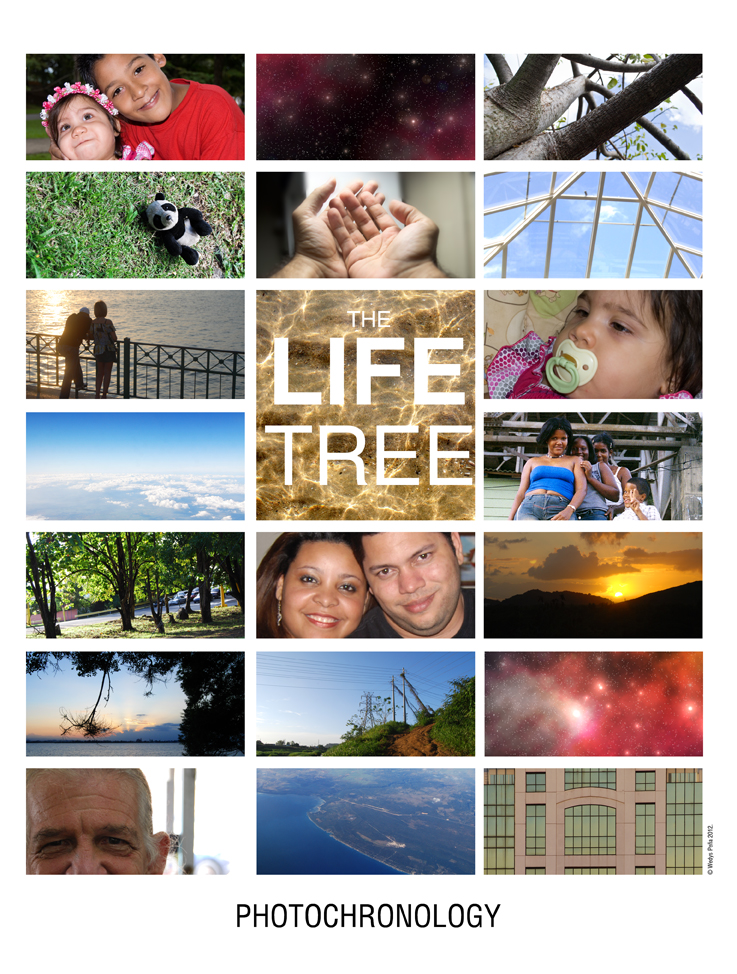Esta pieza, basada en la portade del DVD de la película, fue una recopilación de fotografias a traves de cinco años, siempre he tratado de sobrepasar lo que observa el ojo y llagar a lo que percibe el alma… lo que nos hace humanos. /// This piece, based on the DVD cover of the film, was a recompilation of photographs taken through five years, I have always tried to go beyond what the eye sees y go to what the soul perceives… what makes us human.
“¿Dónde estabas cuando puse las bases de la tierra? ¡Dímelo, si de veras sabes tanto! … ¿Mientras cantaban a coro las estrellas matutinas y todos los ángeles gritaban de alegría?”
Job 38:4,7 (tomada de la NVI)
Con esta cita comienza nuestro viaje, observando la vida cotidiana de los O’Brien, una familia típica de la década de los ’50 a la que quizás hemos pertenecido o que nos hemos podido encontrar en un momento u otro de nuestra vida. Con estas primeras escenas en conjunto a la cita del principio el director (Terrence Malick) nos dice que desde esa perspectiva es contada esta historia. Se nos muestra lo mundano, el día a día de una familia como cualquier otra y, como a cualquiera le puede pasar, la tragedia toca la puerta de esta. Uno de los tres hijos de la familia muere; es éste el conflicto que desata toda la propuesta de Malick. Este hecho coloca una nueva pieza en el tablero, la pregunta perenne de la humanidad al Creador “¿Por qué permites que sucedan cosas malas a personas buenas?” Ahora tenemos a los O’Brien haciendo frente a la pérdida de un miembro de la familia y cuestionando al Creador.
Técnicamente esta película muestra gran virtuosidad de sus creadores. Vemos la gran maestría del manejo de la narrativa visual de Terrence Malick, el cual sin duda alguna es un poeta de la imagen con una visión clara de la historia que quiere contar y de cómo maximizar su impacto emocional dándole una fuerza trascendental a esta pieza en el contexto de nuestra condición humana. La fotografía es de Emmanuel Lubezki la cual tiene una composición casi impecable en sus encuadres, meticulosa atención a los colores y al uso de la luz. La exquisita banda sonora de ésta es más que un elemento para acentuar las imágenes, es una herramienta clave en la narrativa de esta historia que recuerda a uno al director Stanley kubrick utilizando música por autores clásicos como Brahms, Bach, Schumann, entre otros. El montaje, obviando en un principio un orden cronológico de los hechos de la historia, nos enlaza directamente a la emoción que se quiere comunicar aumentando la relevancia de esta obra.
Con frases como “Hay dos formas de vivir la vida: La de la naturaleza, y la de la gracia. Uno tiene que elegir cual forma va a seguir” dicha por la madre e imágenes impresionantes como la creación de la tierra, la película nos da una bella impresión de la vida que puede llevar nuestra mente a lugares que probablemente no haya visitado anteriormente.
Continuará…
***
“Where were you when I laid the foundations of the Earth?…When the morning stars sang together and all the sons of God shouted for joy?”
Job 38: 4,7 (taken from NKJV)
With this quote starts our journey, viewing the everyday life of the O’Brien, a typical family of the 50’s to whom maybe we’ve belonged or seen sometime in our lives. With these images alongside with the quote at the beginning the director (Terrence Malick) tells us that this is the perspective this story is told. We’re shown the mundane; the everyday of a family like any other and like any other tragedy knocks on their door. One of the three sons of the family dies; this is the conflict that unravels the whole point Malick’s making. Now we have a new piece of the puzzle, humanity’s eternal question to the Creator “Why do you permit bad things to happen to good people?” Now we have the O’Brien facing the loss of a member of their family and questioning the Creator.
Technically this film shows great virtuosity from its creators, We see the mastery on the visual narrative of Terrence Malick, whom without a doubt is a poet of the image with a clear vision of the story he wants to tell and how to maximize its emotional impact giving this piece a transcendental strength in the context of our human condition. The photography is from Emmanuel Lubezki which has an almost impeccable composition in its framings, its meticulous attention to the colors and its use of light. The exquisite soundtrack is more than an element to accentuate the images; it’s a key tool in the narrative of this story that reminds us of the director Stanley Kubrick using the music by classic authors such as Brahms, Bach, Schumann, among others. The montage, at first forsaking a chronological order, links us directly to the emotion that wants to communicate augmenting the relevance of this work.
With phrases like “There were two ways through life – the way of nature and the way of grace. You have to choose which one you’ll follow. .” Spoken by the mother (Jessica Chastain) and stunning images like the creation of the earth, the film gives us a beautiful impression on life that con take our minds to places it’s never been.
To be continue…

Esta foto tuya Wedys me hace apreciar mucho mas la pelicula! gracias!
Gracias por tus palabras, Juan.